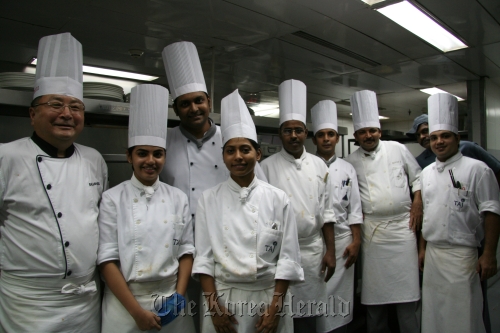MUMBAI ― Cooking Korean food for foreign palates in foreign lands requires much creativeness and resourcefulness.
Chef Bae Han-chul, formerly with the InterContinental Hotel in Seoul and currently a professor at Gangdong University, who served a five-course hansik meal for 200 people at a Korean food promotion gala event in Mumbai last week had to prepare the menu in Seoul, exchange numerous emails with his counterpart at the Taj Mahal Palace Hotel in Mumbai about procuring the right ingredients, fly over to work with the local chefs and train the servers who had never seen Korean food before in the lead up to the first-ever introduction of hansik in the financial hub of India.
The Korean Food Promotion will continue at the Taj Mahal New Delhi Hotel from Sept. 21 to 24 after having completed its run in Mumbai from Sept. 15-17.
Chef Bae is a veteran of introducing Korean cuisine to foreigners ― he led the teams that held hansik promotion events in Washington D.C., Paris and Hong Kong. Yet, preparing for the Mumbai event was a lot more challenging than he first imagined.
Chef Bae Han-chul, formerly with the InterContinental Hotel in Seoul and currently a professor at Gangdong University, who served a five-course hansik meal for 200 people at a Korean food promotion gala event in Mumbai last week had to prepare the menu in Seoul, exchange numerous emails with his counterpart at the Taj Mahal Palace Hotel in Mumbai about procuring the right ingredients, fly over to work with the local chefs and train the servers who had never seen Korean food before in the lead up to the first-ever introduction of hansik in the financial hub of India.
The Korean Food Promotion will continue at the Taj Mahal New Delhi Hotel from Sept. 21 to 24 after having completed its run in Mumbai from Sept. 15-17.
Chef Bae is a veteran of introducing Korean cuisine to foreigners ― he led the teams that held hansik promotion events in Washington D.C., Paris and Hong Kong. Yet, preparing for the Mumbai event was a lot more challenging than he first imagined.

“It was difficult to get ingredients as there are no Korean food stores here. Also, this is the first time that I realized the importance of vegetarianism,” said Bae who had to prepare a vegetarian version of the five-course dinner on top of the regular dinner.
An unforeseen difficulty was the sheer number of guests. “When I left Seoul, I was told we would be serving 70 people. But the guest list grew to 100, and in two hours to 120 and in the end we had to prepare to serve 200 people.” With the assistance of 20 local chefs working in the kitchen along with Chef Park Hee-don from Korea, the gala dinner went without a glitch.
Since one of the goals of the food promotion event was to eventually have the Taj Mahal Palace Hotel offer Korean food at its restaurants, chef Bae developed special dishes, such as grilled vegetables on skewer, neobiani (grilled meat with soy sauce) and samgyetang (chicken with ginseng served in chicken broth), for easier transfer.
“I think the slight twists that I gave to traditional Korean dishes were well received at the gala dinner. Samgyetang was particularly well received,” said Bae, who checks the dishes in the kitchen after each course to gauge the diners’ response. “Neobiani was another hit and everybody likes jeon,” he added.
Different countries respond differently to Korean food, according to Bae. “In Washington japchae and bibimbap were bestsellers while Parisians liked grilled galbi,” he explained.
Some of the dishes served during the gala dinner were presented in ways that may not be considered traditional. For example, samgyetang was presented as chicken breast roll stuffed with ginseng in clear chicken broth rather than the typical whole chicken stuffed with ginseng and glutinous rice.
“This is not fusion Korean food. Fusion means that cooking methods of two countries or more are used. What I did was to change the presentation. I never do fusion food,” said Bae. However, he also cautioned against being obsessed with preserving tradition when presenting Korean cuisine to the world. “The taste must be maintained while localizing the dishes, meaning that the dishes are presented in a way that is easier for the locals to eat,” Bae explained. Most of the successful Korean restaurants in Washington and Paris have localized their presentations, he observed. “After all, a restaurant is successful only when local diners come,” he said.
By Kim Hoo-ran, Culture & Sports Editor
(khooran@heraldcorp.com)








![[Graphic News] More Koreans say they plan long-distance trips this year](http://res.heraldm.com/phpwas/restmb_idxmake.php?idx=644&simg=/content/image/2024/04/17/20240417050828_0.gif&u=)
![[KH Explains] Hyundai's full hybrid edge to pay off amid slow transition to pure EVs](http://res.heraldm.com/phpwas/restmb_idxmake.php?idx=644&simg=/content/image/2024/04/18/20240418050645_0.jpg&u=20240419100350)





![[From the Scene] Monks, Buddhists hail return of remains of Buddhas](http://res.heraldm.com/phpwas/restmb_idxmake.php?idx=652&simg=/content/image/2024/04/19/20240419050617_0.jpg&u=20240419175937)

![[KH Explains] Hyundai's full hybrid edge to pay off amid slow transition to pure EVs](http://res.heraldm.com/phpwas/restmb_idxmake.php?idx=652&simg=/content/image/2024/04/18/20240418050645_0.jpg&u=20240419100350)

![[Today’s K-pop] Illit drops debut single remix](http://res.heraldm.com/phpwas/restmb_idxmake.php?idx=642&simg=/content/image/2024/04/19/20240419050612_0.jpg&u=)